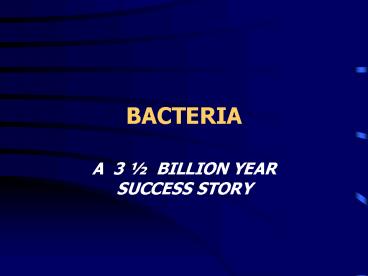BACTERIA - PowerPoint PPT Presentation
1 / 27
Title: BACTERIA
1
BACTERIA
- A 3 ½ BILLION YEAR SUCCESS STORY
2
BACTERIA
- Bacteria are prokaryotic -
- which means they DO NOT have nucleus
3
BACTERIA
- Discovered in the late 1600s by Anton van
Leeuwenhoek - This discovery would not have been possible
WITHOUT the invention of the - MICROSCOPE
4
BACTERIA ARE UNICELLULAR
- Bacteria come in three shapes
- cocci -- round
- bacilli -- rodlike
- spirilla -- spiral shaped
5
STRUCTURE OF A BACTERIAL CELL
- Cell wall surrounds and protects the cell
- Cell membrane inside the cell wall controls
what goes in and out
6
STRUCTURE OF A BACTERIAL CELL
- Cytoplasm gel-like material inside the cell
- Ribosomes protein factories
- Genetic material contains instructions for
cells functions (DNA)
7
STRUCTURE OF A BACTERIAL CELL
- Flagellum (plural -- flagella) long whip
like structure it helps the bacteria to move.
8
TWO KINGDOMS OF BACTERIA
- ARCHAEBACTERIA
- EUBACTERIA
9
KINGDOM ARCHAEBACTERIA
- Means ancient bacteria
- They live in extreme environments
- DO NOT NEED OXYGEN
10
KINGDOM EUBACTERIA
- Chemically different from Archaebacteria
- Do not live in extreme environments, but live
everywhere else - DO NEED OXYGEN
11
REPRODUCTION IN BACTERIA
- Under optimum, or ideal conditions, bacteria
thrive and reproduce quickly - Some bacteria can reproduce as often as once
every 20 minutes!!! - So why isnt the earth covered with bacteria?
12
REPRODUCTION IN BACTERIA
- Binary fission a process in which one cell
divides to form two identical cells - Binary fission is a form of asexual reproduction
- Asexual reproduction involves only one parent.
Offspring are identical to the parent.
13
14
15
REPRODUCTION IN BACTERIA
- Conjugation one bacterium transfers some of its
genetic material - Conjugation is a form of sexual reproduction
which involves two parents
16
SURVIVAL NEEDS OF BACTERIA
- Some bacteria are autotrophic, and some are
heterotrophic - Like other organisms, bacteria get their energy
to perform life processes from food - The process of breaking down food to release
energy is called RESPIRATION
17
SURVIVAL NEEDS OF BACTERIA
- ARE BACTERIA INDESTRUCTIBLE?
- Some bacteria can survive harsh conditions (no
food, drought, poisonous wastes) by forming
endospores.
18
SURVIVAL NEEDS OF BACTERIA
- Endospore structure that allows the bacteria to
survive hostile conditions. - An endospore is a sack around the DNA which
protects it.
19
ARE BACTERIA FRIEND OR FOE?
- Bacterial infections can cause death.
- But that is only the beginning of the story.
20
BACTERIAL FRIENDS
- Lactobacillus acidophilus
- Used for turning milk into yogurt and to preserve
other dairy products
21
BACTERIAL FRIENDS
- Streptomyces
- Soil bacteria used to make streptomycin, an
antibiotic used to treat bacterial infections
22
BACTERIAL FRIENDS
- Pseudomonas putida
- Cleans wastes from sewage water at water
treatment plants
23
BACTERIAL FRIENDS
- Escherichia coli
- Bacteria that live in your colon and small
intestine. Helps you digest your food every day.
24
BACTERIA AT WORK
- Bacteria are used as one of the tools to clean up
oil spills. The bacteria EAT the oil, turning it
into carbon dioxide.
25
BACTERIA AT WORK
- Nitrogen fixing bacteria -- change nitrogen from
the air into OXYGEN!!!
26
BACTERIA Population
- There ARE more bacteria in your mouth than all of
the humans on Earth.
27
BACTERIA Population
- There are over 100 million bacteria on ONE square
inch of your skin. - Both good and bad bacteriaof course.
28
How can we slow bacteria down
- A YOGURT a day keeps the doctor away. By eating
good bacteria found in some foods you can stay
healthier. - If you DO get a bacterial infection antibiotics
CAN helpthey CANNOT help a virus.
29
BACTERIA LESSON OFTHE DAY
- 99 of bacteria are
- HELPFUL!!!!































